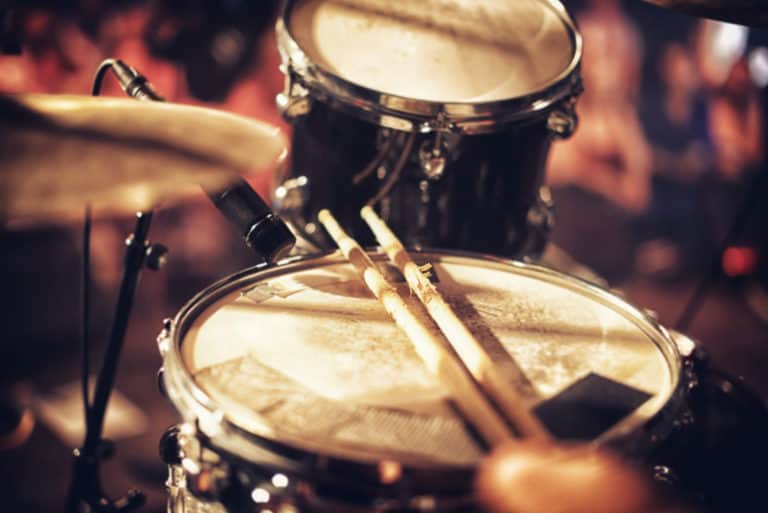Do All Drums Sound the Same? An Honest Answer
A common question I get from people who either aren’t drummers or are newer drummers is “Do All Drums Sound the Same?”
And it’s a completely valid question. Though the drums are the heartbeat of a song, they are primarily meant to stay in the background while vocals and guitars remain in the forefront.
While each type of drum may have a distinct sound, It can be pretty difficult to distinguish the subtle differences from one drum set to another when you’re comparing the same type of drum.
Hundreds of different kinds of drums exist, from hand drums to drums that you beat with percussion mallets. The instrument has evolved over centuries, and today, it exists in various sizes, shapes, and designs. Surely, though, all drums have the same percussive sound, right?
The short answer is, no, drums do not all sound the same. Several factors affect the sound of a drum, like how tight the drumhead is, the depth and diameter of the instrument, and how you play the drum.
Most rock bands consist of at least one drummer, but percussion instruments are shared amongst all types of music. It’s fascinating that drums come in such a variety of shapes, sizes, and sounds.
The rest of this article, we’ll discuss will identify the most common types of drums, what they sound like, and why they sound the way they do!
Factors That Change a Drum’s Sound
Almost all drums have several essential components influencing how the instrument sounds.
The shell is the hollowed-out body of the drum; the head is the top of the drum that gets hit to make a sound. Drummers use tuning bolts to tighten the drum head, which in turn changes the tone of the drum’s sound.
Let’s look at how these materials can affect how a drum sounds.
Drum Shell and Size
The drum shell refers to the body of the instrument. Most drum shells are birch or maple wood; the shell is cut and molded into the appropriate size.
Specific drums, like the snare drum, can be made with wood and metal. The different materials affect the sharpness of the drum’s tone.
When drums first emerged in 5000 BC, the shell was made from hollowed-out tree trunks and could be either tall and skinny or short and wide. The size (or diameter) and depth of the shell affect the drum’s sound. In particular, the larger and deeper the drum, the louder and lower the beat’s tone. The smaller and shorter the shell, the quieter and sharper the tone.
Drum Head
A drum head (or a skin) covers the drum openings. Sometimes, both sides of the shell are covered; other times, just one. Typical drum heads in 2022 are made of polyester through the creation of liquid plastic into thin sheets, which are then cut to an appropriate size to match different drum shell sizes.
Before plastic, drum heads were initially made of animal hide that was dried, stretched, and tightened over the hollowed-out tree trunks that served as the drum’s shell.
The thickness of a drum head is what plays the most impact on how a drum sounds. Thinner skins are best played in lighter songs because they’re more lightweight and less durable. In comparison, thicker skins produce louder, deeper tones and can withstand louder music.
Tuning Bolts
The drum head can be attached to the shell in various ways. Animal skins can be laced or glued to the shell, and plastic skins can connect through a fitted frame or metal ring.
To be used as a drum, the skin must be attached tightly to the shell, and tension must be present. The tuning bolts on the shell of the drum tighten the head. If the head is loose, there will be nothing concrete to hit, and thus the drum will produce no sound.
Not all drums have tuning bolts, but they all have a mechanism for tightening the drum head. It’s a routine part of proper drum maintenance.
Most Popular Drums and Their Sounds
When someone says they play the drums, the first type of instrument that comes to mind for most people is a drum kit, often seen on the stages of rock festivals across the world. However, multiple types of drums exist, like the bongo and cajons—even electric drums are prevalent in today’s music!
Let’s look at some of the most common types of drums and how manufacturers create them.
Drums in a Kit
Drum kits are arranged from left to right, starting with the drum with the highest tone. Not including any of the cymbals, the snare drum is first on the left, followed by the small tom, the large tom, and the floor tom (otherwise known as the kick or bass drum).
The drummer sits behind the drum kit, usually on a small stool, with the snare drum to her left. This positioning gives the player access to foot pedals on her right and left sides, which control the cymbals and the kick drum.
Snare Drum
The snare drum is the smallest in size and depth of all the drums in the kit. As a result, it produces a quick, loud and lively beat. Its shell has both openings covered with two or three-ply skins.
Additionally, snare drums have snare wires stretched on the inner side of the bottom head (the drum head on the bottom of the snare). These wires add to the sharp sound that snares make.
Tom-Toms
The small and large toms, originating many moons ago in China, sit next to each other, mounted either on the floor tom or using drum kit hardware. They have cylindrical shells that have two drum heads.
Tom-toms are deeper than snare drums and lack snare wires. While there are a small handful of differently designed tom-tom drums, musicians primarily use roto toms in a complete drum kit.
The small tom-tom is tuned to produce a higher tone, which it is capable of due to its smaller size and depth. On the other hand, a large tom-tom has a deeper tone with a mild sustain (the note is sustained for a few moments after you play the instrument.
Kick Drum
The kick drum is the largest and sits on the floor beneath the small tom. It’s called a kick drum because the drummer steps on a foot pedal, which swings a mallet into the drum head to produce sound. People also refer to this instrument as the floor tom.
The kick drum acts as the loudest and lowest tone and is an essential part of a standard 5 piece drum kit. It has two drum heads, and when you hit the top head, the drum produces a loud bass tone that gets quieter over time.
You can check out free online drum machines (like Musicca) or Youtube videos for an audio example of how the snare, toms, and kick drum sound.
Hand Drums
Hand drums similarly have both a shell and a drum head. Still, drum makers build them slightly differently than traditional drum kit percussion.
Each hand drum is incredibly unique, and as we’ve already seen with the tom-toms having roots in China, most drums have histories rich in culture.
Bongos and Conga Drums
Bongos and Conga drums, for example, date back to 19th-century Cuba and are often heard in Spanish and Latin American music. These two drums have contrasting shapes and thus, produce different sounds.
Conga drums are tall and barrel-shaped solo drums, with animal hide serving as the drum head. Bongo drums, instead, are two much smaller drums attached together. They call the smaller bongo a hembra and the bigger bongo the macho. The size and depth of the drums influence the sounds they create.
Musicians play these two types of drums differently. They play the bongo with just a few fingers in the center and along the edges of the drum. In contrast, musicians play the conga drum with open hands, typically along the rim of the drum head.
Cajon Drum
Cajon drum boxes have Afro-Peruvian roots, and early drummers used to play on a rectangular-shaped box, like an upside-down drawer (cajon in Spanish means’ drawer’) or, in African cultures, empty fruit crates.
A cajon is a six-sided instrument made primarily of birch or beech wood, with a plywood striking surface (called a tapa on the cajon, but the equivalent of a drum head). Drum makers use materials such as nails to secure the tapa to the cajon, and the body has a sound hole cut into the box.
The percussionist sits atop the cajon because the instrument acts as a drum and a seat and hits the tapa with open hands, palms, or fingers. Not surprisingly, the cajon drum is often heard in flamenco music and can sound different depending on where the player strikes the tapa.
Steel Tongue Drum
One of the most exciting percussion instruments is the steel tongue drum, which does not resemble the other drums very much.
A tongue or tank drum is made by welding two metal bowls together. Metal is the most common material used to make tongue drums today. Still, traditionally they were carved out of wood in Caribbean and Aztec cultures.
While most drums produce sound through vibration and aerodynamics, the tongue drum creates sound through the instrument.
Different steel drums are tuned to specific pitches and have slits cut into the instrument to release the sound. Since the body of a tongue drum is metal, the tone it creates sounds metallic, like the hard or soft ringing of a bell in different pitches.
Tongue drums can be played by hand or with percussion mallets.
Djembes and Tablas
Djembes originate from South Africa and are smaller-sized hand drums. These drums have a hide stretched over an upright wooden shell and secured using string. Drummers pace the instrument between their knees when they play, both standing up and seated.
These drums have a distinctive sound similar to the sound and pitch of a snare drum when players strike the djembe on the rim. When struck in the center of the drum head, the sound is a deeper tone.
Tablas are a unique Indian drum pair, with a male and female in each set. The male drum produces a deeper tone while the female drum creates a higher pitched sound frequently associated with sitars. Players use both fingers and palms to create a very distinctive sound.
The Anatomy of a Drum Beat
So, we know that countless factors influence the sound a drum makes: size and depth of the drum, how tight the drum head is, what the instrument is made of and played with, and so much more. But that doesn’t explain how players produce the drum’s sound. So how do drums work?
Drums create sound through air, vibration, and reverberation. When a drummer strikes a drum head, the vibrating drum head changes the air pressure inside the instrument. The air bounces from head to head (or wall to wall, in the case of the cajon) and reverberates, thus creating sound.
Materials such as wood, steel, plastic, and animal hyde are all composed differently, changing the drum’s pitch or tone. Let’s explore sound frequencies and drum materials to understand these instruments’ pitches better
Sound, Frequency, and Pitch
As previously mentioned, the sound emerges through vibrations. When something vibrates very quickly, it creates a faster and higher frequency, which produces a high pitch.
When something vibrates slowly, it creates a slower frequency, and these frequencies create a low-sounding pitch. Kick drums, for example, produce low frequencies because their head and shell are much larger, therefore vibrating and reverberating at a slower pace when struck.
Percussion Mallets
Percussion mallets are the instruments used to strike the surface of a drum. In rock bands, drummers play with a pair of drumsticks and a foot pedal built with a mallet; when they step on the pedal, the mallet swings forward and hits the center of the kick drum.
In marching bands, drummers use wrapped mallets. Wrapped mallets refer to mallets that drummers place yarn or rubber coverings over to dull the sound it makes against the drum head.
Some percussion mallets are larger while others are on the smaller side, but drummers use both to hit a specific area on the drum head to affect the air pressure inside the instrument. Mallets without coverings create louder, sharper sounds in contrast to covered ones.
Sound Holes
Some drums have a mechanism called a sound hole. Simply put, a sound hole is an exit point for the sound created inside a drum. You will often find sound holes in kick drums or large drums like the cajon. Without a sound hole, the reverberation would sound quiet and muffled, with the drum beat staying inside the instrument.
One side goes uncovered in instruments like bongo or conga drums, allowing the air and sound to escape the drum once struck.
Tongue Drums and Sound
Tongue drums are different because the striking of metal creates certain bell-like tones versus the thumping, tapping, and cracking sounds of a traditional drum.
Drummers strike the tongues on the top of the instrument, and the length of each tongue, and the opening on either side, determine the pentatonic tone. There is also a sound hole in the center of the drum.
Tongue drums are melodic and peaceful, often seen in yoga or meditation studios. They are easy to learn how to play and are usually tuned to a specific scale, which makes it challenging to make a mistake when learning. The NUEVEN Steel Tongue Drum is a simple steel tongue drum that you may purchase on Amazon.
The sound a drum makes comes from the vibrating drum head, which one may strike with one’s hands or a mallet. The vibrations change the air pressure inside the instrument and create a sound that escapes through the sound hole. Countless factors influence the sound a drum makes.
Best Tools To Learn the Drums
Your local music school is the best resource for learning the difference between drums. Music teachers are incredibly knowledgeable; a drum teacher would be the best person to talk to about various drums and their sounds.
Another good option is to visit your local music store and test the percussion instruments. Compare their sounds and try to notice the differences in vibration. Notice how smaller drums sound sharper, perhaps at a higher pitch, while larger drums sound deeper.
Joining drum circles or music events can also train your ear to better identify the various drum sounds. Drum circles typically use handmade drums as opposed to the drums that one might see in a kit, and the percussionists often have extensive experience.
Finally, unlimited drumming websites and apps let you explore the many drum sounds. Drumbit is an app that will allow you to experiment with all instruments in a drum kit. The page immediately directs you to the playing interface that includes the cymbals in a kit.
In Conclusion
To summarize, not every drum sounds the same. Countless factors influence the sound of a drum, like the shape of a drum shell or the material of the striking surface.
The best way to familiarize yourself with drum sounds is to practice listening to them! If you have access to a drum kit, a set of bongos, or even a cajon, sit down and strike the drum’s surface; alternatively, you can have fun playing with online drum apps using the snare, toms, and kick drum to invent your own tracks.







